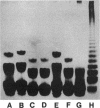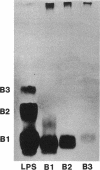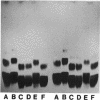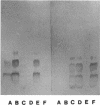Abstract
Lipopolysaccharides (LPSs) isolated from three Kanagawa-positive and three negative strains of Vibrio parahaemolyticus were characterized by using electrophoretic, immunochemical, and chemical methods. The results of this study indicated that the LPSs of all six strains of V. parahaemolyticus examined did not have an O-specific side chain. These V. parahaemolyticus LPSs appeared to have molecular weights similar to that of the rough-type (Ra) LPS of Salmonella typhimurium TV-119 and might just contain lipid A and a core region. However, the microheterogeneity of V. parahaemolyticus LPS observed was greater than that of S. typhimurium LPS. The profile of V. parahaemolyticus LPS consisted of closely spaced triplet or quadruplet bands, but that of S. typhimurium consisted of doublet bands. Slower-moving bands appeared on sodium dodecyl sulfate-polyacrylamide gel electrophoresis gels only when large amounts of V. parahaemolyticus LPS were loaded. These bands were proven to be the aggregates of the fastest-moving low-molecular-weight bands by re-electrophoresis. The banding pattern of V. parahaemolyticus LPSs produced on nitrocellulose membranes by immunoblotting indicated that the V. parahaemolyticus LPSs did not have an O-specific side chain. The low ratio of total carbohydrate to lipid A of V. parahaemolyticus LPSs also suggested that they were like rough-type LPS. The mobility and profile of V. parahaemolyticus LPS on sodium dodecyl sulfate-polyacrylamide gel electrophoresis gel and its chemical composition were closely related to the serotype of a specific strain but not with the Kanagawa phenomenon.
Full text
PDF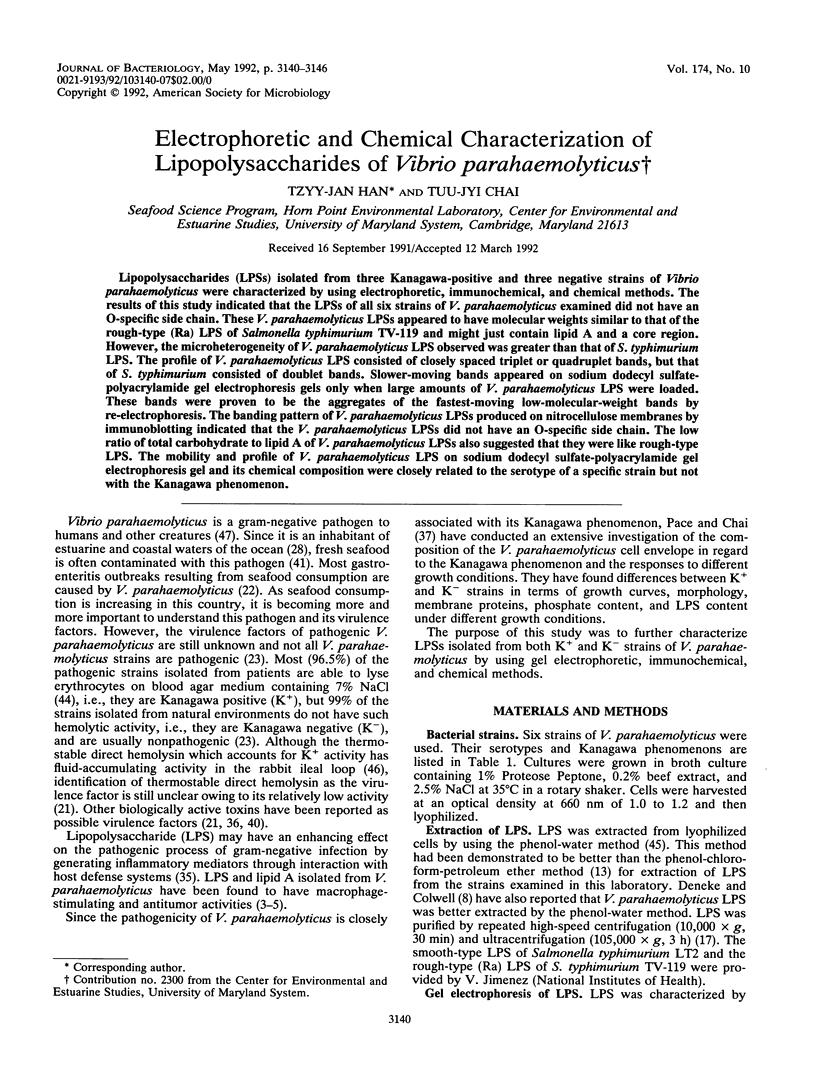
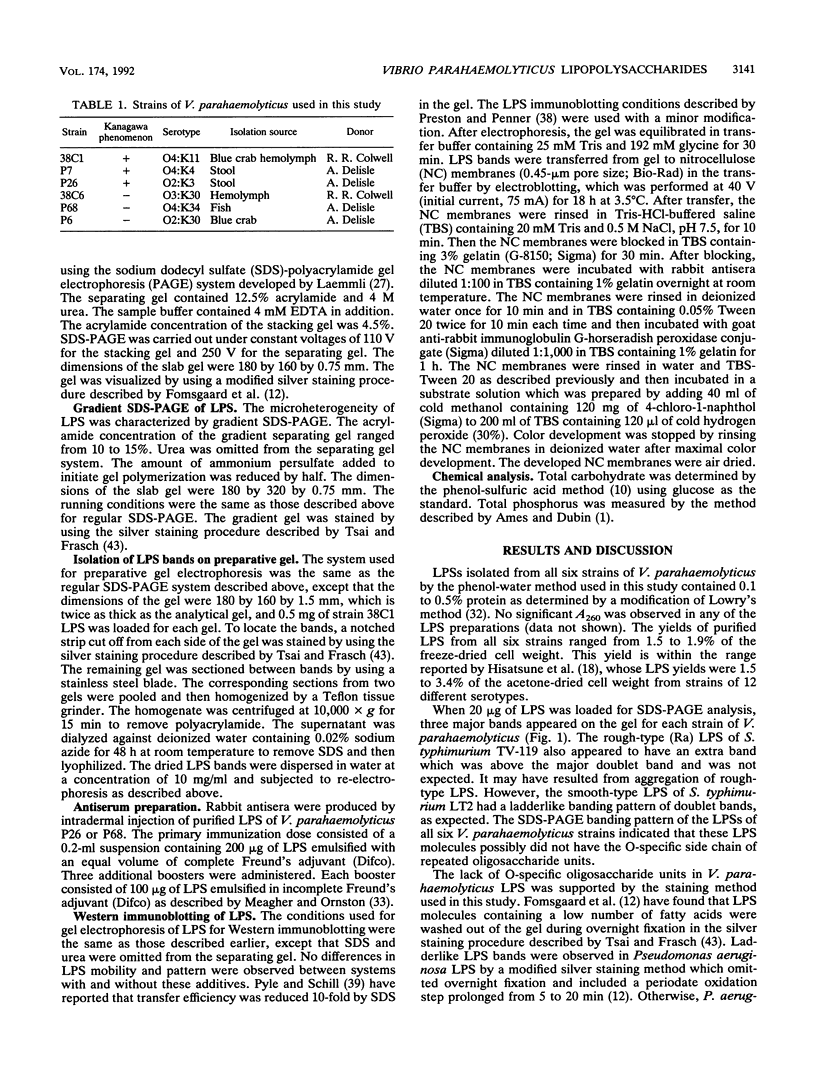
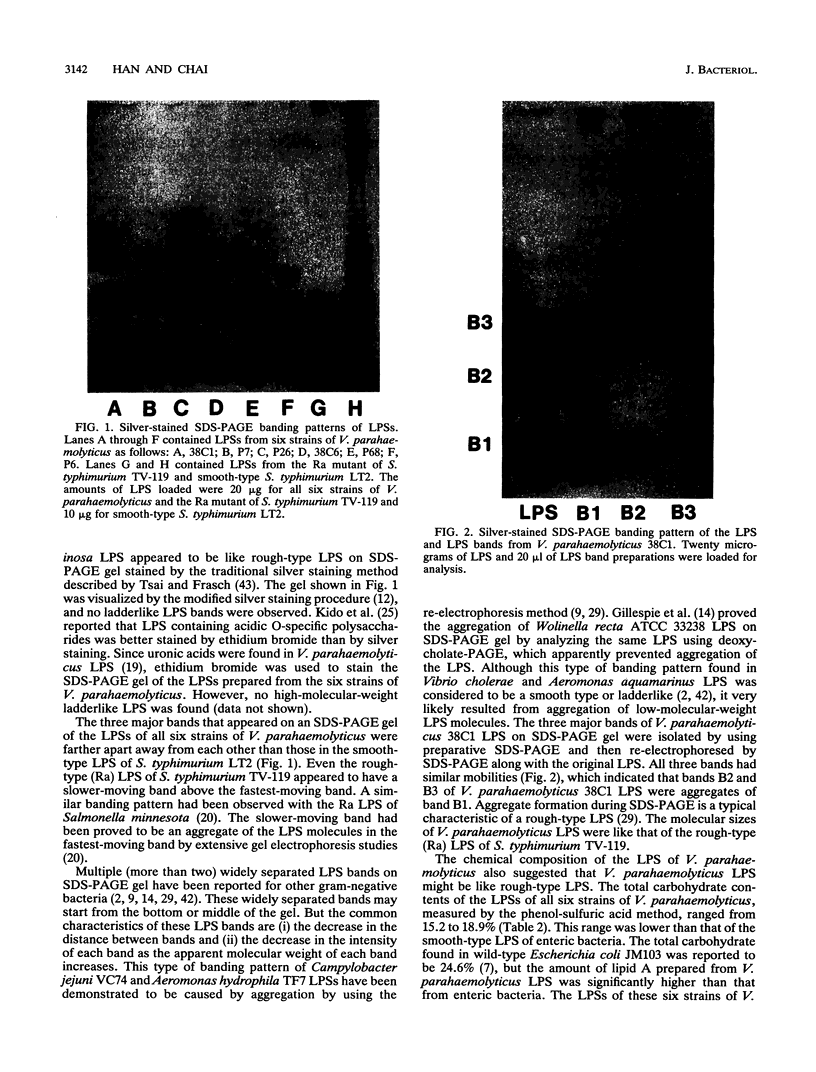
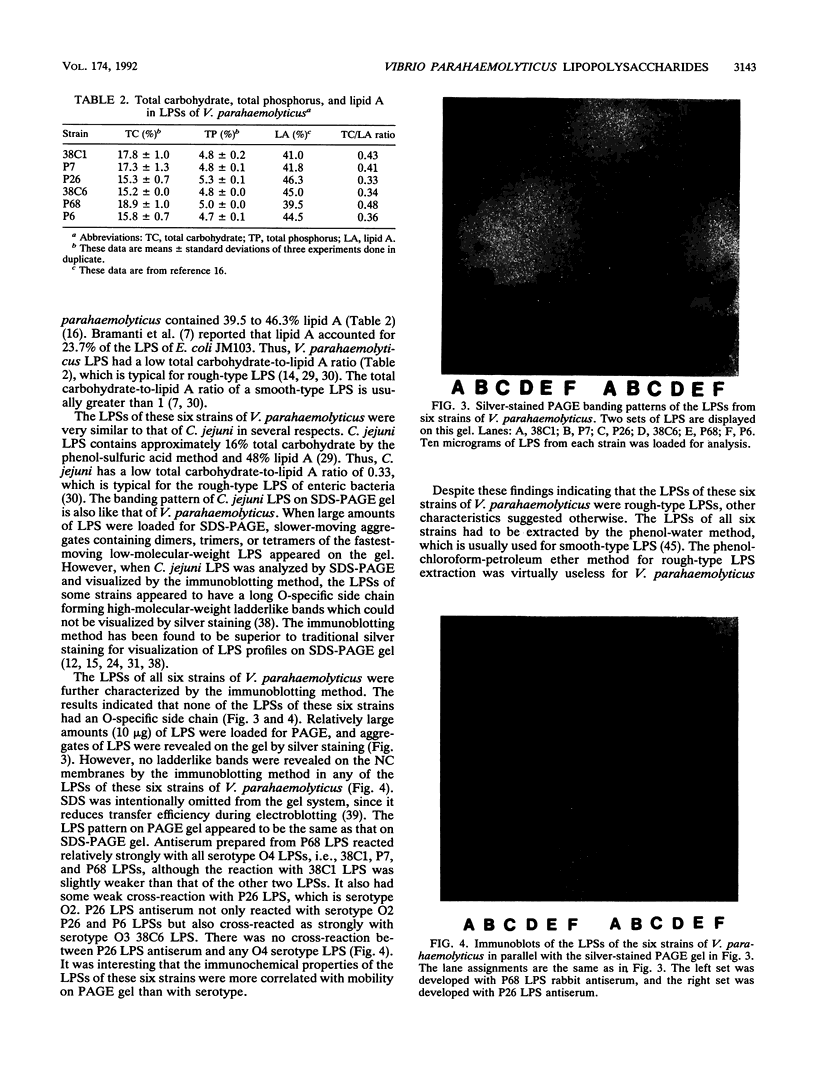
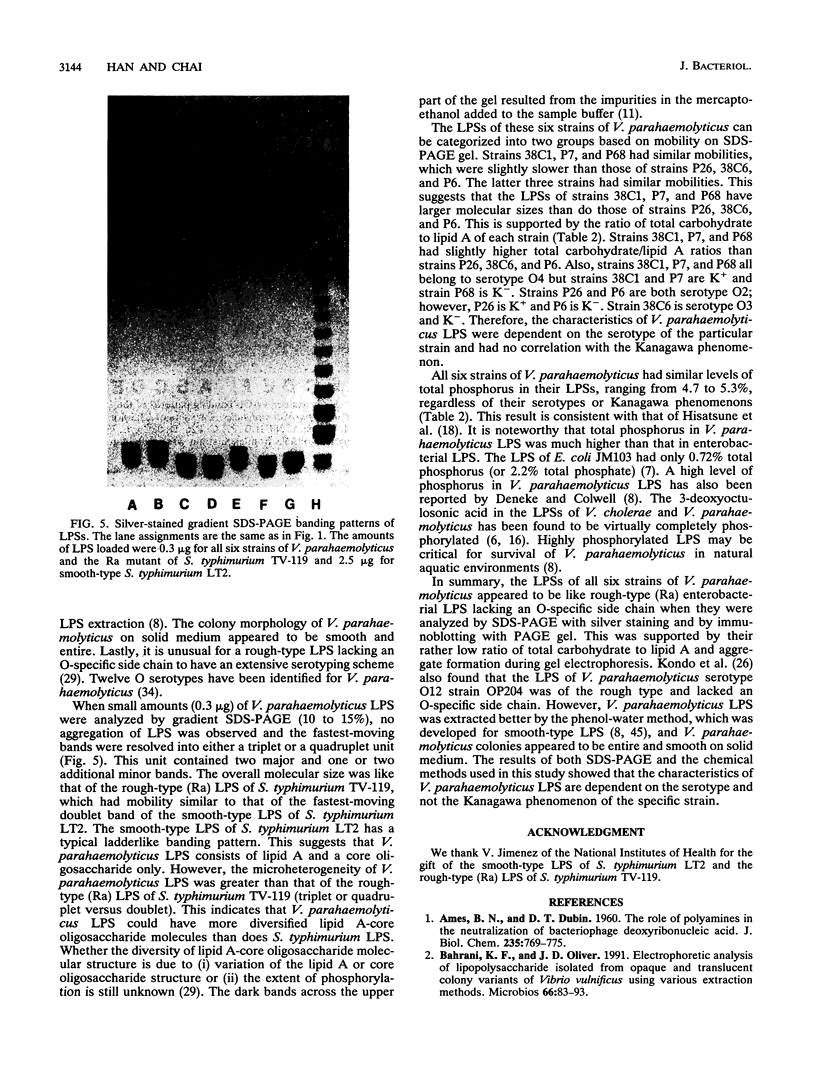
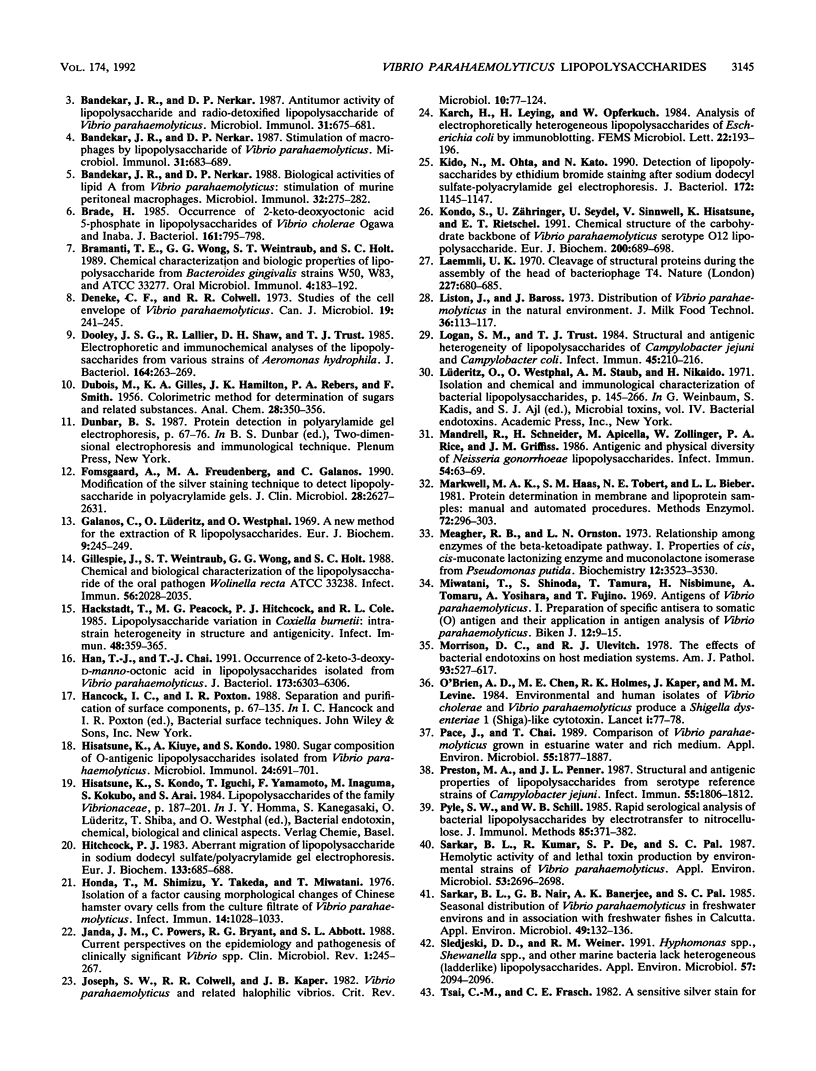
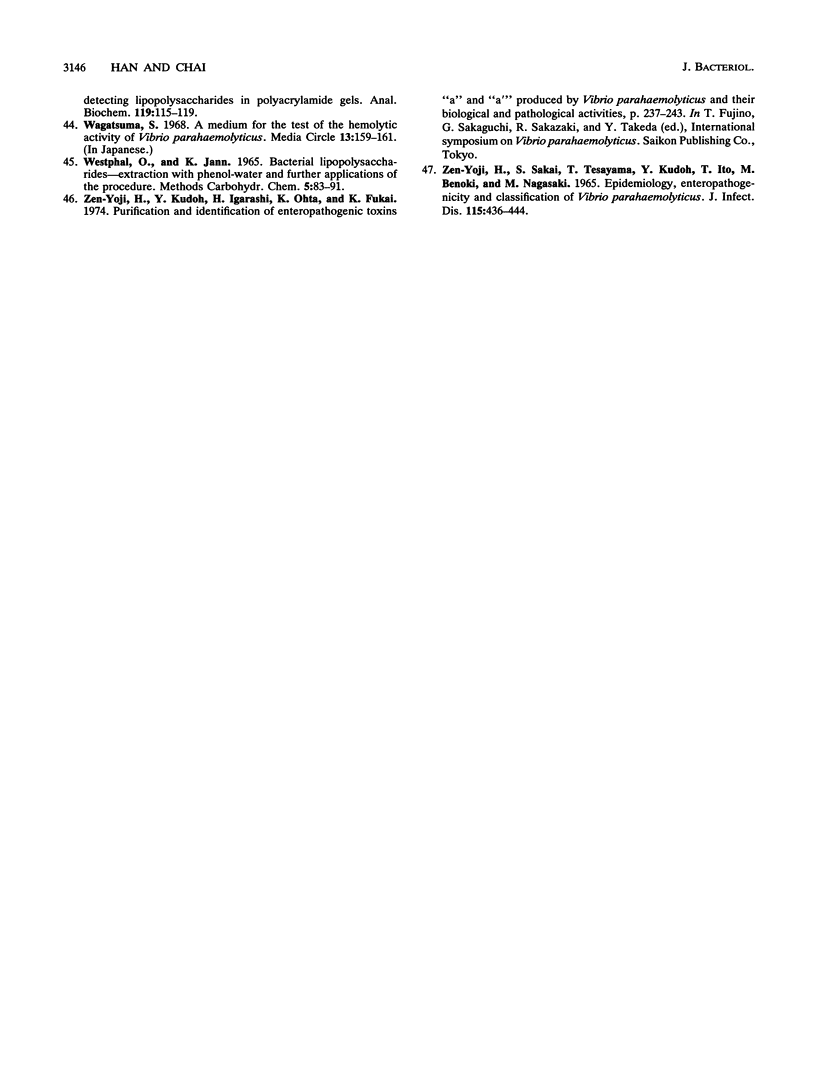
Images in this article
Selected References
These references are in PubMed. This may not be the complete list of references from this article.
- AMES B. N., DUBIN D. T. The role of polyamines in the neutralization of bacteriophage deoxyribonucleic acid. J Biol Chem. 1960 Mar;235:769–775. [PubMed] [Google Scholar]
- Bahrani K. F., Oliver J. D. Electrophoretic analysis of lipopolysaccharide isolated from opaque and translucent colony variants of Vibrio vulnificus using various extraction methods. Microbios. 1991;66(267):83–93. [PubMed] [Google Scholar]
- Bandekar J. R., Nerkar D. P. Antitumor activity of lipopolysaccharide and radio-detoxified lipopolysaccharide of Vibrio parahaemolyticus. Microbiol Immunol. 1987;31(7):675–681. doi: 10.1111/j.1348-0421.1987.tb03128.x. [DOI] [PubMed] [Google Scholar]
- Bandekar J. R., Nerkar D. P. Biological activities of lipid A from Vibrio parahaemolyticus: stimulation of murine peritoneal macrophages. Microbiol Immunol. 1988;32(3):275–282. doi: 10.1111/j.1348-0421.1988.tb01387.x. [DOI] [PubMed] [Google Scholar]
- Bandekar J. R., Nerkar D. P. Stimulation of macrophages by lipopolysaccharide of Vibrio parahaemolyticus. Microbiol Immunol. 1987;31(7):683–689. doi: 10.1111/j.1348-0421.1987.tb03129.x. [DOI] [PubMed] [Google Scholar]
- Brade H. Occurrence of 2-keto-deoxyoctonic acid 5-phosphate in lipopolysaccharides of Vibrio cholerae Ogawa and Inaba. J Bacteriol. 1985 Feb;161(2):795–798. doi: 10.1128/jb.161.2.795-798.1985. [DOI] [PMC free article] [PubMed] [Google Scholar]
- Bramanti T. E., Wong G. G., Weintraub S. T., Holt S. C. Chemical characterization and biologic properties of lipopolysaccharide from Bacteroides gingivalis strains W50, W83, and ATCC 33277. Oral Microbiol Immunol. 1989 Dec;4(4):183–192. doi: 10.1111/j.1399-302x.1989.tb00250.x. [DOI] [PubMed] [Google Scholar]
- Deneke C. F., Colwell R. R. Studies of the cell envelope of Vibrio parahaemolyticus. Can J Microbiol. 1973 Feb;19(2):241–245. doi: 10.1139/m73-036. [DOI] [PubMed] [Google Scholar]
- Dooley J. S., Lallier R., Shaw D. H., Trust T. J. Electrophoretic and immunochemical analyses of the lipopolysaccharides from various strains of Aeromonas hydrophila. J Bacteriol. 1985 Oct;164(1):263–269. doi: 10.1128/jb.164.1.263-269.1985. [DOI] [PMC free article] [PubMed] [Google Scholar]
- Fomsgaard A., Freudenberg M. A., Galanos C. Modification of the silver staining technique to detect lipopolysaccharide in polyacrylamide gels. J Clin Microbiol. 1990 Dec;28(12):2627–2631. doi: 10.1128/jcm.28.12.2627-2631.1990. [DOI] [PMC free article] [PubMed] [Google Scholar]
- Galanos C., Lüderitz O., Westphal O. A new method for the extraction of R lipopolysaccharides. Eur J Biochem. 1969 Jun;9(2):245–249. doi: 10.1111/j.1432-1033.1969.tb00601.x. [DOI] [PubMed] [Google Scholar]
- Gillespie J., Weintraub S. T., Wong G. G., Holt S. C. Chemical and biological characterization of the lipopolysaccharide of the oral pathogen Wolinella recta ATCC 33238. Infect Immun. 1988 Aug;56(8):2028–2035. doi: 10.1128/iai.56.8.2028-2035.1988. [DOI] [PMC free article] [PubMed] [Google Scholar]
- Hackstadt T., Peacock M. G., Hitchcock P. J., Cole R. L. Lipopolysaccharide variation in Coxiella burnetti: intrastrain heterogeneity in structure and antigenicity. Infect Immun. 1985 May;48(2):359–365. doi: 10.1128/iai.48.2.359-365.1985. [DOI] [PMC free article] [PubMed] [Google Scholar]
- Han T. J., Chai T. J. Occurrence of 2-keto-3-deoxy-D-manno-octonic acid in lipopolysaccharides isolated from Vibrio parahaemolyticus. J Bacteriol. 1991 Oct;173(19):6303–6306. doi: 10.1128/jb.173.19.6303-6306.1991. [DOI] [PMC free article] [PubMed] [Google Scholar]
- Hisatsune K., Kiuye A., Kondo S. Sugar composition of O-antigenic lipopolysaccharides isolated from Vibrio parahaemolyticus. Microbiol Immunol. 1980;24(8):691–701. doi: 10.1111/j.1348-0421.1980.tb02870.x. [DOI] [PubMed] [Google Scholar]
- Hitchcock P. J. Aberrant migration of lipopolysaccharide in sodium dodecyl sulfate/polyacrylamide gel electrophoresis. Eur J Biochem. 1983 Jul 1;133(3):685–688. doi: 10.1111/j.1432-1033.1983.tb07517.x. [DOI] [PubMed] [Google Scholar]
- Honda T., Shimizu M., Takeda Y., Miwatani T. Isolation of a factor causing morphological changes of chinese hamster ovary cells from the culture filtrate of Vibrio parahaemolyticus. Infect Immun. 1976 Oct;14(4):1028–1033. doi: 10.1128/iai.14.4.1028-1033.1976. [DOI] [PMC free article] [PubMed] [Google Scholar]
- Janda J. M., Powers C., Bryant R. G., Abbott S. L. Current perspectives on the epidemiology and pathogenesis of clinically significant Vibrio spp. Clin Microbiol Rev. 1988 Jul;1(3):245–267. doi: 10.1128/cmr.1.3.245. [DOI] [PMC free article] [PubMed] [Google Scholar]
- Joseph S. W., Colwell R. R., Kaper J. B. Vibrio parahaemolyticus and related halophilic Vibrios. Crit Rev Microbiol. 1982;10(1):77–124. doi: 10.3109/10408418209113506. [DOI] [PubMed] [Google Scholar]
- Kido N., Ohta M., Kato N. Detection of lipopolysaccharides by ethidium bromide staining after sodium dodecyl sulfate-polyacrylamide gel electrophoresis. J Bacteriol. 1990 Feb;172(2):1145–1147. doi: 10.1128/jb.172.2.1145-1147.1990. [DOI] [PMC free article] [PubMed] [Google Scholar]
- Kondo S., Zähringer U., Seydel U., Sinnwell V., Hisatsune K., Rietschel E. T. Chemical structure of the carbohydrate backbone of Vibrio parahaemolyticus serotype 012 lipopolysaccharide. Eur J Biochem. 1991 Sep 15;200(3):689–698. doi: 10.1111/j.1432-1033.1991.tb16233.x. [DOI] [PubMed] [Google Scholar]
- Laemmli U. K. Cleavage of structural proteins during the assembly of the head of bacteriophage T4. Nature. 1970 Aug 15;227(5259):680–685. doi: 10.1038/227680a0. [DOI] [PubMed] [Google Scholar]
- Logan S. M., Trust T. J. Structural and antigenic heterogeneity of lipopolysaccharides of Campylobacter jejuni and Campylobacter coli. Infect Immun. 1984 Jul;45(1):210–216. doi: 10.1128/iai.45.1.210-216.1984. [DOI] [PMC free article] [PubMed] [Google Scholar]
- Mandrell R., Schneider H., Apicella M., Zollinger W., Rice P. A., Griffiss J. M. Antigenic and physical diversity of Neisseria gonorrhoeae lipooligosaccharides. Infect Immun. 1986 Oct;54(1):63–69. doi: 10.1128/iai.54.1.63-69.1986. [DOI] [PMC free article] [PubMed] [Google Scholar]
- Markwell M. A., Haas S. M., Tolbert N. E., Bieber L. L. Protein determination in membrane and lipoprotein samples: manual and automated procedures. Methods Enzymol. 1981;72:296–303. doi: 10.1016/s0076-6879(81)72018-4. [DOI] [PubMed] [Google Scholar]
- Meagher R. B., Ornston L. N. Relationships among enzymes of the beta-ketoadipate pathway. I. Properties of cis,cis-muconate-lactonizing enzyme and muconolactone isomerase from Pseudomonas putida. Biochemistry. 1973 Aug 28;12(18):3523–3530. doi: 10.1021/bi00742a027. [DOI] [PubMed] [Google Scholar]
- Miwatani T., Shinoda S., Tamura T., Nishimune H., Tomaru A., Yoshihara A., Fujino T. Antigens of Vibrio parahaemolyticus. I. Preparation of specific antisera to somatic (O) antigen and their application in antigen analysis of Vibrio parahaemolyticus. Biken J. 1969 Mar;12(1):9–15. [PubMed] [Google Scholar]
- Morrison D. C., Ulevitch R. J. The effects of bacterial endotoxins on host mediation systems. A review. Am J Pathol. 1978 Nov;93(2):526–618. [PMC free article] [PubMed] [Google Scholar]
- O'Brien A. D., Chen M. E., Holmes R. K., Kaper J., Levine M. M. Environmental and human isolates of Vibrio cholerae and Vibrio parahaemolyticus produce a Shigella dysenteriae 1 (Shiga)-like cytotoxin. Lancet. 1984 Jan 14;1(8368):77–78. doi: 10.1016/s0140-6736(84)90006-0. [DOI] [PubMed] [Google Scholar]
- Pace J., Chai T. J. Comparison of Vibrio parahaemolyticus grown in estuarine water and rich medium. Appl Environ Microbiol. 1989 Aug;55(8):1877–1887. doi: 10.1128/aem.55.8.1877-1887.1989. [DOI] [PMC free article] [PubMed] [Google Scholar]
- Preston M. A., Penner J. L. Structural and antigenic properties of lipopolysaccharides from serotype reference strains of Campylobacter jejuni. Infect Immun. 1987 Aug;55(8):1806–1812. doi: 10.1128/iai.55.8.1806-1812.1987. [DOI] [PMC free article] [PubMed] [Google Scholar]
- Pyle S. W., Schill W. B. Rapid serological analysis of bacterial lipopolysaccharides by electrotransfer to nitrocellulose. J Immunol Methods. 1985 Dec 27;85(2):371–382. doi: 10.1016/0022-1759(85)90146-2. [DOI] [PubMed] [Google Scholar]
- Sarkar B. L., Kumar R., De S. P., Pal S. C. Hemolytic activity of and lethal toxin production by environmental strains of Vibrio parahaemolyticus. Appl Environ Microbiol. 1987 Nov;53(11):2696–2698. doi: 10.1128/aem.53.11.2696-2698.1987. [DOI] [PMC free article] [PubMed] [Google Scholar]
- Sarkar B. L., Nair G. B., Banerjee A. K., Pal S. C. Seasonal distribution of Vibrio parahaemolyticus in freshwater environs and in association with freshwater fishes in Calcutta. Appl Environ Microbiol. 1985 Jan;49(1):132–136. doi: 10.1128/aem.49.1.132-136.1985. [DOI] [PMC free article] [PubMed] [Google Scholar]
- Sledjeski D. D., Weiner R. M. Hyphomonas spp., Shewanella spp., and Other Marine Bacteria Lack Heterogeneous (Ladderlike) Lipopolysaccharides. Appl Environ Microbiol. 1991 Jul;57(7):2094–2096. doi: 10.1128/aem.57.7.2094-2096.1991. [DOI] [PMC free article] [PubMed] [Google Scholar]
- Tsai C. M., Frasch C. E. A sensitive silver stain for detecting lipopolysaccharides in polyacrylamide gels. Anal Biochem. 1982 Jan 1;119(1):115–119. doi: 10.1016/0003-2697(82)90673-x. [DOI] [PubMed] [Google Scholar]
- Zen-Yoji H., Sakai S., Terayama T., Kudo Y., Ito T., Benoki M., Nagasaki M. Epidemiology, enteropathogenicity, and classification of Vi.rio parahaemolyticus. J Infect Dis. 1965 Dec;115(5):436–444. doi: 10.1093/infdis/115.5.436. [DOI] [PubMed] [Google Scholar]



